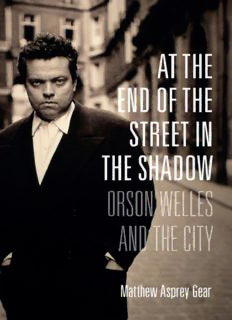
At the End of the Street in the Shadow: Orson Welles and the City PDF
Preview At the End of the Street in the Shadow: Orson Welles and the City
AT THE END OF THE STREET IN THE SHADOW AT THE END OF THE STREET IN THE SHADOW ORSON WELLES AND THE CITY Matthew Asprey Gear A Wallflower Press Book Wallflower Press is an imprint of Columbia University Press publishers since 1893 New York cup.columbia.edu Copyright ©2016 Matthew Asprey Gear All rights reserved E-ISBN 978-0-231-85090-2 Wallflower Press® is a registered trademark of Columbia University Press A complete CIP record is available from the Library of Congress ISBN 978-0-231-17340-7 (cloth : alk. paper) ISBN 978- 0-231-17341-4 (pbk. : alk. paper) ISBN 978-0-231-85090-2 (e-book) A Columbia University Press E-book. CUP would be pleased to hear about your reading experience with this e-book at cup- [email protected]. Cover image: Orson Welles photographed in Paris in 1952, by Fred Brommet This book is for my mother Contents Acknowledgements INTRODUCTION PRELUDE A NUISANCE IN A FACTORY | Hollywood: 1939–48, 1956–58 WELLES’S U.S.A. 1. THE DECLINE AND FALL OF THE LINCOLN REPUBLIC 2. AN EMPIRE UPON AN EMPIRE | Citizen Kane (1941) 3. THE DARKENING MIDLAND | The Magnificent Ambersons (1942) PAN-AMERICA 4. DARKNESS AND FEAR | The Early Anti-fascist Thrillers 5. THE RAUCOUS RAGGLE-TAGGLE JAMBOREE OF THE STREETS It’s All True (unfinished, 1942) 6. RATLINE TO MAIN STREET | The Stranger (1946) 7. PORT TO PORT | The Lady from Shanghai (1947) 8. THE BORDER | Touch of Evil (1958) 9. RETURN TO THE PERIPHERY | The Other Man (unproduced, 1977) INTERLUDE A FREE MAN IS EVERYWHERE | Europe & Beyond: 1947–55, 1958–85 POSTWAR EUROPE 10. SKIES AND RUBBLESCAPE | Mr. Arkadin/Confidential Report (1955) 11. LOST IN A LABYRINTH | The Trial (1962) IMMORTAL STORIES 12. TO ADORE THE IMPOSSIBLE 13. IN THE LAND OF DON QUIXOTE Index Acknowledgements I am grateful to the Orson Welles scholars who generously shared their time and ideas with me during the research for and writing of this book: James Naremore, Jonathan Rosenbaum, Stefan Drössler, Josh Karp, and Scott Simmon. I also want to thank Kate Hutchens at the Special Collections Library at the University of Michigan and David Frasier at the Lilly Library at Indiana University for their hospitality and help during my research visits in January and February 2014, respectively. This book builds on the Touch of Evil chapter of my PhD thesis, completed at Macquarie University, Sydney, in 2011. Further funding from the university allowed me to make a research trip to the Filmmuseum München and present a preliminary version of the chapter on Mr. Arkadin at the ‘Screen’ conference at the University of Glasgow in the summer of 2013. I also want to thank Peter Doyle, Noel King, Theodore Ell, Yoram Allon at Wallflower Press, Gary Morris at Bright Lights Film Journal, Ray Kelly at wellesnet.com, Luc Sante, Will Straw, Adrian Martin, Clive Sinclair, the late Lester Goran, Kathryn Millard, Mark Evans, Nicole Anderson, Iván Zatz, and from the early days Bill Wrobel and Adriano. Many thanks to Soledad Rusoci for her support throughout the writing of this book. Thanks also to Julie Asprey, Luke Asprey, Clare Anderson, Jace Davies, Amanda Layton, Ben Packham for his early insights into Citizen Kane, and in Buenos Aires Sabrina Díaz Bialos, Ignacio Bosero, Arthur Chaslot, Valeria Meiller, and Nuestra Señora de los Candados. Matthew Asprey Gear Biblioteca Nacional de Maestros, Buenos Aires September 2015 INTRODUCTION 1. We could begin almost anywhere. He seems to have visited all the cities so precociously early that every return was tinged with saudade – that untranslatable Portuguese word signifying nostalgic longing and the sweet sadness of loss. In fact, he picked up the word in Rio de Janeiro during what he later remembered as “the last great carnival in that greatest of carnival cities”.1 In the words of Bill Krohn, Orson Welles was “a man of many nostalgias”.2 So let’s begin in Vienna, close to the Cold War border but also the former heart of the Austro-Hungarian Empire, one of several politically obsolete cultures Welles gently lamented during his forty-five years in cinema. In ‘New Wien’, a short travel segment he made for television in the late 1960s, our corpulent guide puffs a cigar and trails a billowing lodenmantel – “purely utilitarian”, he insists – through the wintry solitude of the city.3 Welles peers through the front window of Demel, “the greatest of all the great Viennese pastry shops”, and remembers how “when the world was young I used to run riot in there. How sweet it was”. The grand opulence of Welles’s hotel suite is merely de rigueur – “here at the Hotel Sacher that’s the way it is”. He wonders “how much pink champagne must have been poured here into how many pretty ladies’ slippers”, and remarks that late at night one can still “seem to hear again the clop clop of the horse-drawn Fiakers bringing the old playboys back”. He remembers from his “own childhood days the formidable Frau Sacher herself”. As a child Welles was an international gadabout – “the best cities were certainly Budapest and Peking”, he recalled4 – who dubiously claimed
Description: